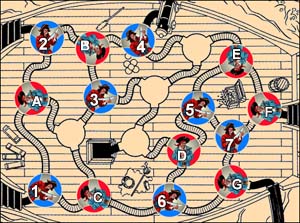Loyal Captain
Capt'n W. Kidd refuses to capture the Loyal Captain since his ship sails under
the British flag. For the first time the crew mutinies! without success this
first time, however.
The Rules in Brief:
-
Each player has 7 tokens in their color available.
-
The players take turns each moving one of their tokens (either: place a new one
or: move 1 from a space to an adjoining space).
-
Tokens, or groups of tokens, which are threatened by opposing pirates on all
sides are captured and removed from the game. A token threatens another if it
could theoretically move onto it on its next turn.
-
A player who cannot move or place any tokens loses the game.
Tactical Hints and Rules Clarifications:
Re 2: At the start of the game it's a good idea to bring on as many
tokens as possible as a strong board presence offers more opportunities to move
and capture. But in doing so take care that one's pieces are not surrounded by
the opposition.
On the other hand, near the end of the game it is a great advantage if one
still has one (or two) tokens in reserve and available for placement.
Tokens must always be moved forward to the next space. The token is oriented so
that its back points to the space from which it came. Since rotation on a space
is forbidden, it cannot be returned directly back to the space from which it
came. In addition, no token may be moved into an occupied space.
Re 3: Capture via surrounding.
If an individual token is surrounded by three opposing tokens, which could
theoretically reach its space on its next turn, it is captured. A token on a
Starting space is captured by just two opponent tokens. Captured tokens are
removed from the game.
Connected, same color groups of tokens are captured if every space connected to
this group is occupied by an opposing pirate, each of which does not point to a
group member with its bottom side. But if even a single connected space is
vacant or occupied so that the bottom side of the token points to the group,
the group is not captured. Thus, as in the classic game Go, leave internal
holes to protect a group. Since tokens cannot be placed just anywhere, a single
hole is often sufficient to secure a group.
On the other hand, a player is occasionally dissolved out of his secure
position since he has to move exactly one token every round (or place a new one
on a Starting space).
A further method of protection is to move behind an opposing token because as
long as the opposing token presents its back, your token cannot be captured.
However, it is possible to lose the game due to inability to move.

1 is captured by C and A.
B is captured by 2, 3, and 4.
5 and 7 are captured as a group by D, E, F, and G.
E and F are not captured since there is a vacant space connected to E.
2 is not captured even though B indeed is adjacent, but 2 is not threatened.
Similarly, G is not threatened by 7 and 6 is not threatened by C and D.
If a token is placed on a space which is already threatened by two opposing
tokens, the newly-placed piece is immediately captured. Exception: if by this
placement at least one of the two other tokens is captured, then the placed
token is not captured.
Re 4: End of the Game
A player unable to move (or place) any pieces loses.
In certain situations it can happen that neither of the players can prevent the
others from moving. In this case the players agree to a stalemate.
A stalemate is usually clearly recognizable by both players. If there is
disagreement over a stalemate, then the player rejecting it has twenty more
turns to prove their point by actually managing a win. If they do not succeed in
defeating the opponent in twenty turns, they lose the game.
If during this twenty turn period a token is captured, the turn count begins
anew.
Start-up Variant:
One player decides the placement position of each of the first tokens for both
sides, then the other chooses which of these pieces, and hence the color, to play as.
|